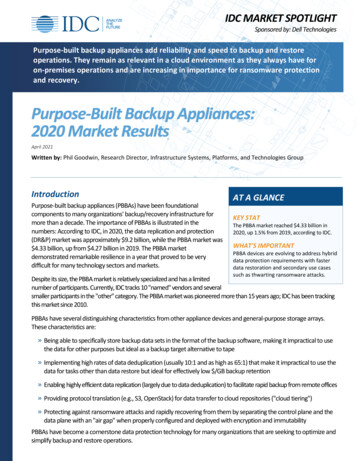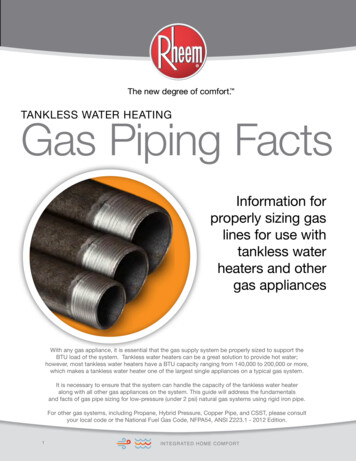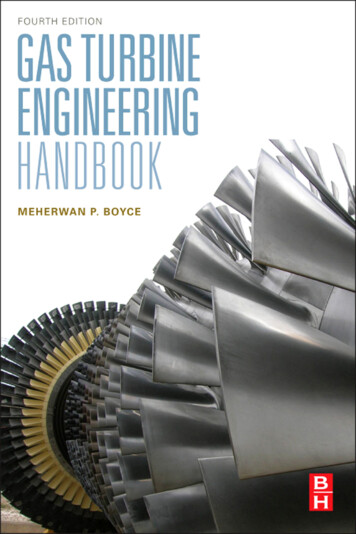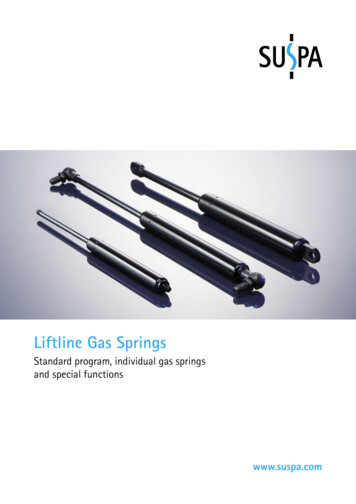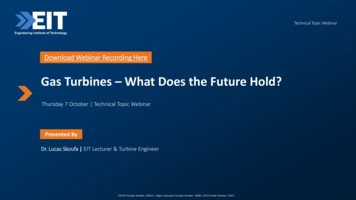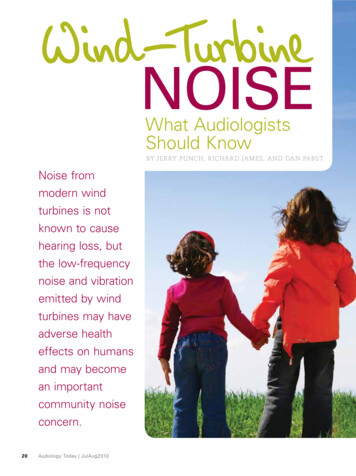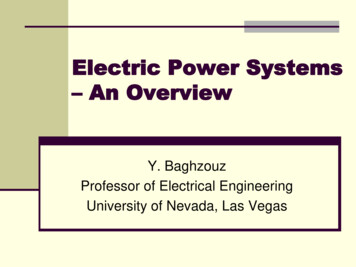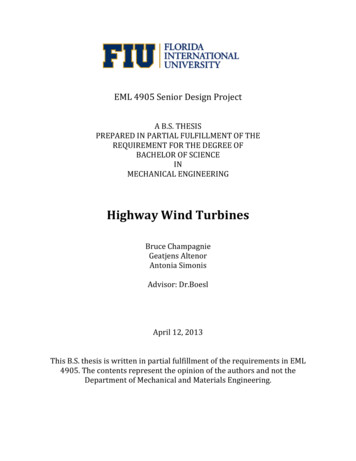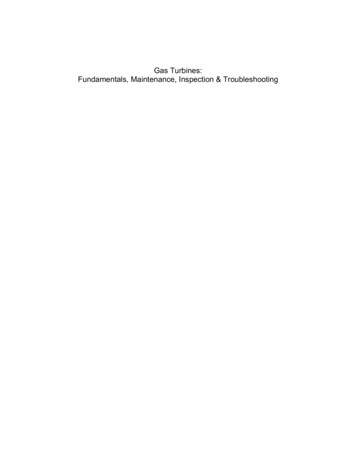
Transcription
Gas Turbines:Fundamentals, Maintenance, Inspection & Troubleshooting
THIS BOOK WAS DEVELOPED BY IDC TECHNOLOGIESWHO ARE WE?IDC Technologies is internationally acknowledged as the premier provider of practical, technical trainingfor engineers and technicians.We specialize in the fields of electrical systems, industrial data communications, telecommunications,automation and control, mechanical engineering, chemical and civil engineering, and are continuallyadding to our portfolio of over 60 different workshops. Our instructors are highly respected in their fieldsof expertise and in the last ten years have trained over 200,000 engineers, scientists and technicians.With offices conveniently located worldwide, IDC Technologies has an enthusiastic team of professionalengineers, technicians and support staff who are committed to providing the highest level of training andconsultancy.TECHNICAL WORKSHOPSTRAINING THAT WORKSWe deliver engineering and technology training that will maximize your business goals. In today’scompetitive environment, you require training that will help you and your organization to achieve its goalsand produce a large return on investment. With our ‘training that works’ objective you and yourorganization will: Get job-related skills that you need to achieve your business goals Improve the operation and design of your equipment and plant Improve your troubleshooting abilities Sharpen your competitive edge Boost morale and retain valuable staff Save time and moneyEXPERT INSTRUCTORSWe search the world for good quality instructors who have three outstanding attributes:1. Expert knowledge and experience – of the course topic2. Superb training abilities – to ensure the know-how is transferred effectively and quickly to you ina practical, hands-on way3. Listening skills – they listen carefully to the needs of the participants and want to ensure that youbenefit from the experience.Each and every instructor is evaluated by the delegates and we assess the presentation after every class toensure that the instructor stays on track in presenting outstanding courses.HANDS-ON APPROACH TO TRAININGAll IDC Technologies workshops include practical, hands-on sessions where the delegates are given theopportunity to apply in practice the theory they have learnt.REFERENCE MATERIALSA fully illustrated workshop book with hundreds of pages of tables, charts, figures and handy hints, plusconsiderable reference material is provided FREE of charge to each delegate.ACCREDITATION AND CONTINUING EDUCATIONSatisfactory completion of all IDC workshops satisfies the requirements of the International Associationfor Continuing Education and Training for the award of 1.4 Continuing Education Units.IDC workshops also satisfy criteria for Continuing Professional Development according to therequirements of the Institution of Electrical Engineers and Institution of Measurement and Control in theUK, Institution of Engineers in Australia, Institution of Engineers New Zealand, and others.
CERTIFICATE OF ATTENDANCEEach delegate receives a Certificate of Attendance documenting their experience.100% MONEY BACK GUARANTEEIDC Technologies’ engineers have put considerable time and experience into ensuring that you gainmaximum value from each workshop. If by lunchtime on the first day you decide that the workshop is notappropriate for your requirements, please let us know so that we can arrange a 100% refund of your fee.ONSITE WORKSHOPSAll IDC Technologies Training Workshops are available on an on-site basis, presented at the venue ofyour choice, saving delegates travel time and expenses, thus providing your company with even greatersavings.OFFICE LOCATIONSAUSTRALIA CANADA INDIA IRELAND MALAYSIA NEW ZEALAND POLAND SINGAPORE SOUTH AFRICA UNITED KINGDOM UNITED STATESidc@idc-online.comwww.idc-online.comVisit our website for FREE Pocket GuidesIDC Technologies produce a set of 6 Pocket Guides used bythousands of engineers and technicians worldwide.Vol. 1 – ELECTRONICSVol. 4 – INSTRUMENTATIONVol. 2 – ELECTRICALVol. 5 – FORMULAE & CONVERSIONSVol. 3 – COMMUNICATIONS Vol. 6 – INDUSTRIAL AUTOMATIONTo download a FREE copy of these internationally best selling pocket guides go to:www.idc-online.com/downloads/On-Site TrainingSAVE MORETHAN 50% OFFthe per personcostCUSTOMISE thetraining to YOURWORKPLACE!Have the trainingdelivered WHENAND WHERE youneed it!All IDC Technologies Training Workshops are available on an on-site basis, presented at the venue ofyour choice, saving delegates travel time and expenses, thus providing your company with evengreater savings.For more information or a FREE detailed proposal contact Kevin Baker by e-mailing:training@idc-online.com
IDC TECHNOLOGIESWorldwide OfficesAUSTRALIATelephone: 1300 138 522 Facsimile: 1300 138 533West Coast Office1031 Wellington Street, West Perth, WA 6005PO Box 1093, West Perth, WA 6872East Coast OfficePO Box 1750, North Sydney, NSW 2059CANADAToll Free Telephone: 1800 324 4244 Toll Free Facsimile: 1800 434 4045Suite 402, 814 Richards Street, Vancouver, NC V6B 3A7INDIATelephone : 91 444 208 935335 4th Street, Kumaran Colony, Vadapalani, Chennai 600026IRELANDTelephone : 353 1 473 3190 Facsimile: 353 1 473 3191PO Box 8069, Shankill Co DublinMALAYSIATelephone: 60 3 5192 3800 Facsimile: 60 3 5192 380126 Jalan Kota Raja E27/E, Hicom Town CenterSeksyen 27, 40400 Shah Alam, SelangorNEW ZEALANDTelephone: 64 9 263 4759 Facsimile: 64 9 262 2304Parkview Towers, 28 Davies Avenue, Manukau CityPO Box 76-142, Manukau CityPOLANDTelephone: 48 12 6304 746 Facsimile: 48 12 6304 750ul. Krakowska 50, 30-083 Balice, KrakowSINGAPORETelephone: 65 6224 6298 Facsimile: 65 6224 7922100 Eu Tong Sen Street, #04-11 Pearl’s Centre, Singapore 059812SOUTH AFRICATelephone: 27 87 751 4294 or 27 79 629 5706 Facsimile: 27 11 312 215068 Pretorius Street, President Park, MidrandPO Box 389, Halfway House 1685UNITED KINGDOMTelephone: 44 20 8335 4014 Facsimile: 44 20 8335 4120Suite 18, Fitzroy House, Lynwood Drive, Worcester Park, Surrey KT4 7ATUNITED STATESToll Free Telephone: 1800 324 4244 Toll Free Facsimile: 1800 434 40457101 Highway 71 West #200, Austin TX 78735Website: www.idc-online.comEmail: idc@idc-online.com
PresentsGas Turbines:Fundamentals, Maintenance,Inspection and TroubleshootingRevision 9Website: www.idc-online.comE-mail: idc@idc-online.com
IDC Technologies Pty LtdPO Box 1093, West Perth, Western Australia 6872Offices in Australia, New Zealand, Singapore, United Kingdom, Ireland, Malaysia, Poland, United States ofAmerica, Canada, South Africa and IndiaCopyright IDC Technologies 2012. All rights reserved.First published 2009All rights to this publication, associated software and workshop are reserved. No part of this publicationmay be reproduced, stored in a retrieval system or transmitted in any form or by any means electronic,mechanical, photocopying, recording or otherwise without the prior written permission of the publisher. Allenquiries should be made to the publisher at the address above.DisclaimerWhilst all reasonable care has been taken to ensure that the descriptions, opinions, programs, listings,software and diagrams are accurate and workable, IDC Technologies do not accept any legal responsibilityor liability to any person, organization or other entity for any direct loss, consequential loss or damage,however caused, that may be suffered as a result of the use of this publication or the associated workshopand software.In case of any uncertainty, we recommend that you contact IDC Technologies for clarification or assistance.TrademarksAll logos and trademarks belong to, and are copyrighted to, their companies respectively.AcknowledgementsIDC Technologies expresses its sincere thanks to all those engineers and technicians on our trainingworkshops who freely made available their expertise in preparing this manual.
ContentsPreface1vGeneral Overview of Gas nFrame type heavy-duty gas turbinesIndustrial type gas turbinesAircraft derivative gas turbinesComparison between aircraft-derivative and industrialheavy-duty turbinesSmall and micro gas turbinesAircraft gas turbinesGas turbine components5678Fundamental Gas Turbine Cycle e cycles with ideal gasesConstant pressure or Brayton cycleIdeal inter-cooled and reheat cyclesActual gas turbine cyclesList of terms and symbols usedGas Turbine .103.113.12CompressorsCentrifugal compressorsAxial-flow compressorsCompressor theoryCompressor aerodynamicsCommon problems affecting axial compressor operationand performanceAir compressor performance characteristicsCombustorsCombustor performance and efficiencyTurbinesFuel nozzles and ignitersEmission control55586367748489
4Materials of Construction4.14.24.34.44.5567IntroductionGeneral metallurgical behavior in gas turbinesGas turbine blade materialsBlade manufacturing techniquesFuture materials95959599107108Bearings and 115119121121Bearing materialsThrough hardened materialsCase hardened materialsCage materialsBabbittsBearing design principlesTilting-pad journal bearingsDesign of thrust bearingsSealsLubrication System in Gas 2134135135135136137137IntroductionOil reservoirPumps and oil jetsLubrication oil filtersOil coolersRelief valvesLubricant selectionOil system cleaning and conditioningFilter selectionOil sampling and testingFuels and fuel supply l specifications and fuel propertiesOther important fuel propertiesFuel treatmentEconomics of fuel selectionGas fuelsHeavy fuelsComparative fuel costsCleaning of turbine componentsFuel supply and control systemsDual-fuel operation and operational flexibilityIntegrated gasification combined cycle
89101112Sound Suppression in Exhausts, Air Requirements andEnvironmental Considerations1538.18.28.3153154155Noise from gas turbine enginesAircraft sound suppression methodsAir requirements and environmental considerationsAuxiliary ting systemsFuel washing systemsGearsGear design and performance parametersCouplings and shaft alignmentShaft alignmentPerformance and Mechanical Equipment rmance standardsMechanical standardsControl Systems and 11.911.10185187193193195198201202206208Control systemsStartup and shutdown considerationsControl of the equipment during operationLifecycle costsCondition monitoring systems and their implementationTemperature, pressure and vibration measurementCampbell diagramGas turbine performance measurement and calculationsProtection systems and alarmsFailure diagnosticsInstallation Requirements, Operation and 0Installation requirementsPhilosophy of maintenanceMaintenance techniquesMaintenance of critical gas turbine componentsMaintenance planning and schedulingSpares and inventory managementMaintenance toolsInspectionGas turbine overhaul and repairTrainingTraining typesTypical problems
12.1312.1412.1512.16Health monitoring in gas turbinesTroubleshooting in gas turbinesGeneral troubleshooting techniques for compressors,combustors and turbinesEvaluation of the effectiveness of gas turbine 3Appendix A: ExercisesAppendix B: Exercise AnswersAppendix C: Revised Practical SessionsAppendix D: Answers253269275279
PrefaceGas turbines are increasingly being used in power plants both in the utility and power sectors for theircompactness, tremendous energy producing capacity, inherent flexibility, operational reliability, highperformance and multiple fuel capability. The last few years have witnessed an exponential growth inthis field, especially technological advances that have resulted in the design and development of highlyefficient gas turbine units. Today, gas turbines have found wide acceptance in a variety of applicationsranging from the petrochemical industry to the sophisticated aircraft industry. With the continuingfocus on designing more and more efficient gas turbine engines, the potential for growth in this field isunlimited.Capabilities and constraintsIn addition to possessing most of the qualities of other types of engines, gas turbines as primemovers possess certain other distinct advantages, some of which are:1. Advantage of direct firing.2. Low ratio of weight to output power.3. Lack of heavy vibrations.4. Power output in the form of rotary motion.5. High performance and reliability arising out of the intrinsic simplicity of the basic turbine cycle.6. Absence of high operating pressures and unbalanced forces.7. Availability of turbine exhaust heat8. Multiple fuel application9. Lowest maintenance and capital costs among major prime movers.As a producer of shaft power, the turbine may be utilized in power generation, pumps and compressordrives and many other applications requiring a dependable shaft power output. But it is specifically inthe fields of energy savings and lower manpower costs that the gas turbine excels. With heat recoveryfrom the exhaust and the production of shaft power output, recovery of 75% to 80% of the total fuelinput to the turbine is a real possibility. The low manpower requirements of a gas turbine unit is bestillustrated by the fact that most of the modern day turbines have their control function performed from aremote location.The most important advances made in gas turbine technology have originated from the aircraft industry.This has revolutionized commercial air transportation. Along with its obvious advantage of greaterspeed over the conventional piston type engine, the jet gas turbine engine has also posted a remarkablerecord of dependability.The profitable application of a gas turbine engine to a specific market, depends largely on the generaleconomic factors governing the market and also local influences such as manpower, fuel and electricenergy costs. Another area where the gas turbine has gained rapid acceptance is the field of electricpower generation. Many power generation gas turbines provide peaking power at remote locationsaway from the base load condition. What makes them attractive for peaking service is their smallerspace requirement, low noise level and operational dependability when unattended. In nearly allapplications, the simple cycle gas turbine is normally chosen for peaking service on account of its lowerinstalled cost. Additionally, the extremely low load factor of a peaking station does not warrant the useof heat recovery apparatus. However, in other electric power generation installations of a base load
character, it is a generally accepted practice to use a recuperative gas turbine type or some other type ofheat recovery device. Some other electric power generation installations use a combined gas and steamturbine cycle where the hot gas turbine exhaust stream rich in oxygen, provides preheated combustionair for the boilers generating steam for the turbine.The efficiency of a gas turbine is governed to a large extent by two important factors, namely pressureratio and temperature. Developments in the recent past have resulted in pressure ratios of 35:1 andturbine inlet temperatures as high as 1600 C (2912 F).This increase in pressure ratio no doubtcontributes to a substantial increase in gas turbine thermal efficiency, when accompanied by asubsequent increase in turbine firing temperature. But increasing the pressure ratio beyond a certainvalue, actually tends to lower the overall cycle efficiency in addition to reducing the operating range ofthe compressor. This may result in the compressor becoming more intolerant to dirt build-up in the inletair filter and compressor blades and thereby creating large drops in cycle performance and efficiency. Itmay sometimes lead to compressor surge, a flameout or even cause serious damage to the compressorblades and components such as radial and thrust bearings of the turbine. Furthermore, the high inlettemperature conditions have a disastrous effect on turbine blade life. Proper cooling must be providedto achieve optimum blade cooling to temperatures below the onset of hot corrosion. The developmentsin recent times of highly efficient turbine blade cooling techniques and also related developments in thefield of material and coating technology have led to minimizing the adverse effects of high temperatureon turbine blades.Another offshoot of these high temperature conditions is the increase in the emission of toxic nitrogenoxide emissions. Environmental considerations demand that the system’s impact on the environment bewithin legal limits and this therefore needs to be carefully addressed. The development of new dry lownitrogen oxide combustors have contributed to significantly reducing the nitrogen oxide output althoughthat has warranted a further increase in the number of fuel nozzles and the complexity of the controlalgorithms.For most power generation purposes the gas turbine unit is operated at a constant speed, as anyvariation could cause major grid problems. Control over the load has to be exercised by controlling thefuel input and therefore the turbine firing temperature and also the inlet guide vane position controllingthe air flow. The effect of this is to try and maintain the exhaust temperature from the gas turbine at arelatively high value, especially in combined cycle or cogeneration plants. This is especially so, sincethis gas is used in the heat recovery steam generator whose effectiveness is in turn dependent on thistemperatureThe gas turbine engine has among the lowest capital and maintenance costs of any major power plant.The design of gas turbines involves certain essential requirements such as: High system reliability and efficiency. Ease of installation and maintenance. Conformance to environmental standards. Flexibility with regard to meeting various service and fuel requirements. Incorporation of reliable control and auxiliary systems.The two factors which have the maximum impact on turbine efficiency are pressure ratio and firingtemperature. The developments over the last few years have seen a dramatic increase in the pressureratio, accompanied by an increase in turbine firing temperatures. The increase in these parameters haswitnessed huge improvements in both the overall efficiency of the plant and the work output.Significant improvements in turbine blade metallurgy and the incorporation of effective coolingtechniques have helped overcome the problems associated with the rising turbine firing temperatures.
Availability and reliability together constitute one of the most important parameters in the design of agas turbine plant. While availability refers to the percentage of time that a given plant is available inorder to generate power in a given period of time, reliability is the percentage of time between plannedoverhauls.Availability is given by A (P-S-F ) 100 %PWhereP is the period of time normally assumed as one year and amounting to 8760 hoursS is the scheduled outage hours for planned maintenance andF is the forced outage hours on account of breakdown and repairReliability is given by R (P-F) 100 %PSome important design considerations with regard to achieving a high availability and reliability factorare blade and shaft stresses, blade loading, material integrity and the auxiliary and control systems.Easy installation and serviceability are critical to the gas turbine design. The advantage with gasturbine units is that they can be tested and packaged at the factory itself. Adoption of the modularsystem of gas turbine design coupled with readily available monitoring and inspection ports at allmajor points, especially the hot section, and easily serviceable parts such as split casings andcombustion cans have also contributed to the ease of service.The unit is also designed such that of its operation must be within legal limits. Care must be taken toensure low emission of dangerous compounds such as nitrogen oxides, sulphur-dioxide, carbonmonoxide and hydrocarbons. This problem has been largely alleviated by the use of catalytic and dry,low-nitrogen oxide combustors.Control systems control various critical operational parameters such as fuel supply, pressure,temperature and vibration throughout the operating range of the plant. Unfortunately, they alsocontribute a large deal to machine downtime, when they malfunction. Therefore proper attentionshould be paid towards their design and also the design of auxiliary systems such as lubrication andstarting systems. Additionally the auxiliary systems mentioned must have backup systems foremergency requirements.Flexibility in design and operation is a must, especially when the turbine is operating under variousoperating conditions. There is also a need for flexibility regarding the fuel type in the form of a turbineunit with multiple fuel applications, as different turbine fuels may be in short supply at different times.There are a number of variables that affect the ultimate design and choice of gas turbines. They are thenature and type of application, location of the proposed plant and its size, the type of fuel proposed foruse, the planned operation mode and the startup techniques that are likely to be used. Although gasturbines are used in a multitude of applications, the three major types are aircraft propulsion,mechanical drives and power generation. The gas turbines used for aircraft propulsion are basically ofthree types, the turbojet, the turbofan and the turboprop. The gas turbines used as mechanical drivesare used extensively for driving pumps and compressors in the petro-chemical industry and mostlyconsist of aero-derivative turbines. The turbines used for power generation include small turbines ofless than 2 MW capacity, the medium ones with capacities between 5 and 50 MW, and the larger
power turbines in the range between 50 and 480 MW, operating at very high pressure ratios and firingtemperatures.The location of the plant is another important determining factor for choosing the turbine type, forexample, aero-derivative engines being chosen for offshore applications, industrial turbines chosen forpetro-chemical applications and large frame type heavy duty turbines chosen for power generation.The size of the plant is another important consideration in evaluating plant costs; the larger the size,the less the initial cost per unit of power produced. Although the aircraft-derivative turbines havetraditionally been very efficient, recent developments have led to the design and development of newerframe type turbines having higher efficiencies.The proposed fuel to be used, the planned plant operation mode and the type of starting system are theother important factors governing the selection of a gas turbine engine. As regards the fuel type,natural gas when readily available is found to be most suitable for use as gas turbine fuel, because ofthe low maintenance costs involved and its minimal effect on the environment. Most of the other fuelshave higher contamination levels. They require online washing to minimize the harmful effects of theirconstituents on the turbine components. Plant operation mode refers to the type of load conditions thegas turbine is used in – like base and peak loads. The startup of gas turbines is generally achieved bythe use of electric diesel or air motors and even by steam turbines.This manual contains a detailed study of gas turbines beginning with a general overview of the variousturbine types. Then follows a separate chapter dedicated to the fundamentals of gas turbinethermodynamics consisting of both the ideal and actual gas turbine cycles and concluding with adiscussion on compressor characteristics and the combustion process. This is followed by a discussionon the design, function and operating principles of the different components like compressors,combustors, turbines, igniters and fuel nozzles.Considering their importance, a whole chapter is dedicated to the study of the materials of constructionand material trends with emphasis on present and future materials in addition to including a discussionon coating technology. A detailed discussion is also included on the turbine bearings, seals andcouplings the design of which is critical to efficient turbine performance, followed by a study of thelubrication and fuel systems. A detailed mention is also made of the air quality requirements andenvironmental considerations along with the emission control measures and exhaust soundsuppression techniques. This is followed by a discussion on the auxiliary systems such as starting andfuel washing systems.The performance and mechanical standards governing gas turbine performance are dealt withexclusively, with particular emphasis on ASME and API standards. Turbine control systems andinstrumentation which are vital to the efficient operation of the turbine and encompassing varied topicslike condition monitoring systems, estimation, measurement and actual calculations of turbineperformance parameters, life cycle costs and diagnostic systems are also discussed separately.Last but not the least comes a comprehensive discussion on the various aspects governing gas turbineoperation and maintenance with particular emphasis on the different maintenance techniques, thestandard inspection, overhaul and repair procedures including a discussion on the latest inspectiontechniques like borescopy. Topics like maintenance planning and scheduling, tools, training anddocumentation are also exclusively dealt with, along with the typical problems encountered in gasturbines. The discussion concludes with a general evaluation of the maintenance procedures that areusually followed.
1General Overview of Gas Turbines1.1IntroductionGas turbine engines are generally classified based on the type and nature of application, size andlocation. This chapter contains a general overview of the different types of gas turbines in use, andalso a brief introduction to the various components comprising the gas turbine engine in addition todiscussing the concept of heat recovery in combined cycle gas turbine plants. Gas turbines ingeneral are broadly classified into five categories. They are: Frame type heavy-duty Industrial type Aircraft derivative Small gas turbines Micro-turbinesThese categories of turbines are discussed in detail from the point of view of their design,construction, principle of working and application.1.2Frame type heavy-duty gas turbinesFrame type heavy-duty gas turbines are high-efficiency machines finding widespread application asprime movers in large power generation units. A majority of modern day heavy duty gas turbineswork on the combined gas turbine cycle, although earlier gas turbines of this type were designedmainly as an extension of steam turbines. With the success encountered in achieving higher firingtemperatures in the range of 1426 C (2600 F), the efficiency levels of these categories of turbineshave been found to reach as much as 50%. A sectional view of a typical heavy duty gas turbine isshown in Figure 1.1.
2 Gas Turbines: Troubleshooting, Maintenance and InspectionFigure 1.1Sectional view of a frame type gas turbineSince space and weight restrictions are not considered that important in the design of theseturbines, they are large with distinct features like heavy wall casings, large diameter combustors,thick-sectioned blades and large frontal areas. These turbines largely employ multistage axial-flowcompressors and turbines, with multiple can-annular combustors connected to each other bycrossover tubes. The cross-over tubes achieve flame propagation from one chamber to the otherand pressure equalization between each chamber. A common example of this type is the GE heavyduty large gas turbine. However not all frame type turbines employ can-annular combustors. Whilethe older Siemens V type heavy duty turbines employed silo type combustors, the newer ones useannular combustors with Hybrid Burner Ring. Certain designs also employ annular combustorswith sequential firing. Examples being Alstom GT 24, 26.The multistage operation of the compressors is carried out in stages, varying between 15 and 17, inorder to achieve high overall pressure ratios in the range between 16:1 and 25:1. As the pressureincrease is carried out in many stages, there is a small pressure rise in each stage and therefore theoperation is highly stable. The compressor along with the generator is driven by the expandersection usually consisting of a 2-4 stage axial flow turbine. The compressor, turbine and combustortypes are discussed in the chapters to follow.Although these units produce large noise levels, they are nowhere as high as that produced inaircraft derivative turbines. Their large frontal areas reduce the air inlet velocity and thereby airnoise. The advantages with these turbines are their long life, high operating reliability, highavailability and high overall efficiency.As mentioned earlier, the high efficiency levels achieved in these turbine types are partly due to thehigh turbine inlet temperatures of around 1371 C (2500 F). Research is continuously on to pushthis temperature up further to around 1649 C (3000 F), which would make these turbines evenmore efficient.
General Overview of Gas Turbines 31.3Industrial type gas turbinesIndustrial Type gas turbines are medium range gas turbines and are quite similar in design to theheavy duty gas turbines, but with reduced power outputs. They are largely used in petrochemicalplants an
1.7 Aircraft gas turbines 7 1.8 Gas turbine components 8 2 Fundamental Gas Turbine Cycle Thermodynamics 19 2.1 Reversible cycles with ideal gases 19 2.2 Constant pressure or Brayton cycle 19 2.3 Ideal inter-cooled and reheat cycles 25 2.4 Actual gas turbine cycles 34 2.5 List of terms and sym


